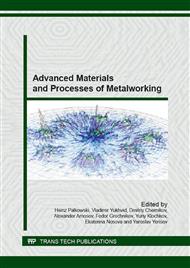[1]
Giuseppe Sala, A numerical and experimental approach to optimise sheet stamping technologies: part II - aluminium alloys rubber-forming, Materials and Design. 22 (2001) 299-315.
DOI: 10.1016/s0261-3069(00)00088-1
Google Scholar
[2]
Zhang De-Hai, Bai Dai-Ping, Liu Ji-bin, Guo Zhe, Guo Cheng, Formability behaviors of 2A12 thin-wall part based on DYNAFORM and stamping experiment, Composites: Part B. 55 (2013) 591–598.
DOI: 10.1016/j.compositesb.2013.07.001
Google Scholar
[3]
Nicolas Tardif, Stelios Kyriakides, Determination of anisotropy and material hardening for aluminum sheet metal, International Journal of Solids and Structures. 49 (2012) 3496–3506.
DOI: 10.1016/j.ijsolstr.2012.01.011
Google Scholar
[4]
A. Güner, C. Soyarslan, A. Brosius, A.E. Tekkaya, Characterization of anisotropy of sheet metals employing inhomogeneous strain fields for Yld2000-2D yield function, International Journal of Solids and Structures. 49 (2012) 3517–3527.
DOI: 10.1016/j.ijsolstr.2012.05.001
Google Scholar
[5]
Olaf Engler, Carmen Schäfer, Ole Runar Myhr, Effect of natural ageing and pre-straining on strength and anisotropy in aluminium alloy AA 6016, Materials Science & Engineering A. 639 (2015) 65–74.
DOI: 10.1016/j.msea.2015.04.097
Google Scholar
[6]
Giuseppe Sala, A numerical and experimental approach to optimise sheet stamping technologies, Part I: mild steel press-forming, Materials and Design. 22 (2001) 285-298.
DOI: 10.1016/s0261-3069(00)00087-x
Google Scholar
[7]
Masaaki Nakaia, Mitsuo Niinomia, Junko Hiedaa, Ken Choa, Yuya Nagasawab, Takashi Konnoc, Yoshinori Itod, Yoshio Itsumic, Hideto Oyamac, Reduction in anisotropy of mechanical properties of coilable (α+β)-type titanium alloy thin sheet through simple heat treatment for use in next-generation aircraft applications, Materials Science and Engineering: A. Volume 594, 31 (2014).
DOI: 10.1016/j.msea.2013.11.055
Google Scholar
[8]
Y.G. An, H. Vegter, S. Melzer, P. Romano Triguero, Evolution of the plastic anisotropy with straining and its implication on formability for sheet metals, Journal of Materials Processing Technology, Volume 213. 8 (2013) 1419–1425.
DOI: 10.1016/j.jmatprotec.2013.02.008
Google Scholar
[9]
Fusahito Yoshida, Hiroshi Hamasaki, Takeshi Uemori, A model of anisotropy evolution of sheet metals, Procedia Engineering. 81 (2014) 1216 – 1221.
DOI: 10.1016/j.proeng.2014.10.100
Google Scholar
[10]
Jurij Sidor, Roumen H. Petrov, Leo A.I. Kestens, Deformation, recrystallization and plastic anisotropy of asymmetrically rolled aluminum sheets, Materials Science and Engineering: A, Volume 528. 1 (2010) 413–424.
DOI: 10.1016/j.msea.2010.09.023
Google Scholar


